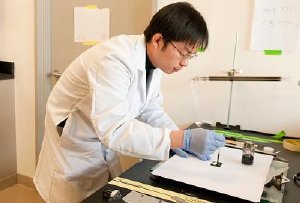Feb 20 2010
By dipping ordinary paper or fabric in a special ink infused with nanoparticles, Stanford engineer Yi Cui has found a way to cheaply and efficiently manufacture lightweight paper batteries and supercapacitors (which, like batteries, store energy, but by electrostatic rather than chemical means), as well as stretchable, conductive textiles known as "eTextiles" - capable of storing energy while retaining the mechanical properties of ordinary paper or fabric.
 Bing Hu, a post-doctoral fellow in Yi Cui's research group at Stanford, prepares a small square of ordinary paper with an ink that will deposit nanotubes on the surface that can then be charged with energy to create a battery. Credit: L.A. Cicero
Bing Hu, a post-doctoral fellow in Yi Cui's research group at Stanford, prepares a small square of ordinary paper with an ink that will deposit nanotubes on the surface that can then be charged with energy to create a battery. Credit: L.A. Cicero
While the technology is still new, Cui's team has envisioned numerous functional uses for their inventions. Homes of the future could one day be lined with energy-storing wallpaper. Gadget lovers would be able to charge their portable appliances on the go, simply plugging them into an outlet woven into their T-shirts. Energy textiles might also be used to create moving-display apparel, reactive high-performance sportswear and wearable power for a soldier's battle gear.
The key ingredients in developing these high-tech products are not visible to the human eye. Nanostructures, which can be assembled in patterns that allow them to transport electricity, may provide the solutions to a number of problems encountered with electrical storage devices currently available on the market.
The type of nanoparticle used in the Cui group's experimental devices varies according to the intended function of the product – lithium cobalt oxide is a common compound used for batteries, while single-walled carbon nanotubes, or SWNTs, are used for supercapacitors.
Cui, an assistant professor of materials science and engineering at Stanford, leads a research group that investigates new applications of nanoscale materials. The objective, said Cui, is not only to supply answers to theoretical inquiries but also to pursue projects with practical value. Recently, his team has focused on ways to integrate nanotechnology into the realm of energy development.
"Energy storage is a pretty old research field," said Cui. "Supercapacitors, batteries – those things are old. How do you really make a revolutionary impact in this field? It requires quite a dramatic difference of thinking."
While electrical energy storage devices have come a long way since Alessandro Volta debuted the world's first electrical cell in 1800, the technology is facing yet another revolution. Current methods of manufacturing energy storage devices can be capital intensive and environmentally hazardous, and the end products have noticeable performance constraints – conventional lithium ion batteries have a limited storage capacity and are costly to manufacture, while traditional capacitors provide high power but at the expense of energy storage capacity.
With a little help from new science, the batteries of the future may not look anything like the bulky metal units we've grown accustomed to. Nanotechnology is favored as a remedy both for its economic appeal and its capability to improve energy performance in devices that integrate it. Replacing the carbon (graphite) anodes found in lithium ion batteries with anodes of silicon nanowires, for example, has the potential to increase their storage capacity by 10 times, according to experiments conducted by Cui's team.
Silicon had previously been recognized as a favorable anode material because it can hold a larger amount of lithium than carbon. But applications of silicon were limited by its inability to sustain physical stress – namely, the fourfold volume increase that silicon undergoes when lithium ions attach themselves to a silicon anode in the process of charging a battery, as well as the shrinkage that occurs when lithium ions are drawn out as it discharges. The result was that silicon structures would disintegrate, causing anodes of this material to lose much if not all of their storage capacity.
Cui and collaborators demonstrated in previous publications in Nature, Nanotechnology and Nano Letters that the use of silicon nanowire battery electrodes, mechanically capable of withstanding the absorption and discharge of lithium ions, was one way to sidestep the problem.
The findings hold promise for the development of rechargeable lithium batteries offering a longer life cycle and higher energy capacity than their contemporaries. Silicon nanowire technology may one day find a home in electric cars, portable electronic devices and implantable medical appliances.
Cui now hopes to direct his research toward studying both the "hard science" behind the electrical properties of nanomaterials and designing real-world applications.
"This is the right time to really see what we learn from nanoscience and do practical applications that are extremely promising," said Cui. "The beauty of this is, it combines the lowest cost technology that you can find to the highest tech nanotechnology to produce something great. I think this is a very exciting idea … a huge impact for society."